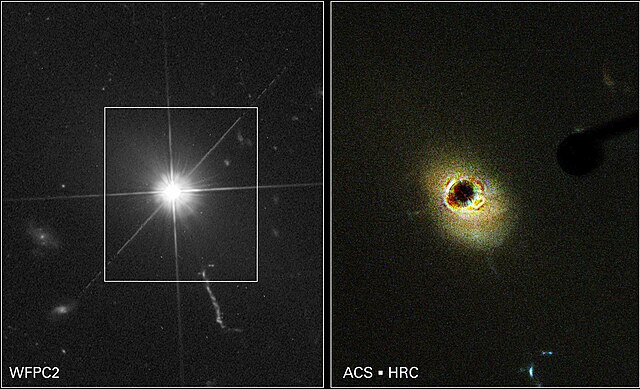A quasar is an extremely luminous active galactic nucleus (AGN). It is sometimes known as a quasi-stellar object, abbreviated QSO. The emission from an AGN is powered by a supermassive black hole with a mass ranging from millions to tens of billions of solar masses, surrounded by a gaseous accretion disc. Gas in the disc falling towards the black hole heats up and releases energy in the form of electromagnetic radiation. The radiant energy of quasars is enormous; the most powerful quasars have luminosities thousands of times greater than that of a galaxy such as the Milky Way. Quasars are usually categorized as a subclass of the more general category of AGN. The redshifts of quasars are of cosmological origin.
Artist's rendering of the accretion disc in ULAS J1120+0641, a very distant quasar powered by a supermassive black hole with a mass two billion times that of the Sun
Hubble images of quasar 3C 273. At right, a coronagraph is used to block the quasar's light, making it easier to detect the surrounding host galaxy.
A cosmic mirage known as the Einstein Cross. Four apparent images are actually from the same quasar.
Quasars in interacting galaxies
An active galactic nucleus (AGN) is a compact region at the center of a galaxy that emits a significant amount of energy across the electromagnetic spectrum, with characteristics indicating that this luminosity is not produced by the stars. Such excess, non-stellar emissions have been observed in the radio, microwave, infrared, optical, ultra-violet, X-ray and gamma ray wavebands. A galaxy hosting an AGN is called an active galaxy. The non-stellar radiation from an AGN is theorized to result from the accretion of matter by a supermassive black hole at the center of its host galaxy.
Quasar 3C 273 observed by the Hubble Space Telescope. The relativistic jet of 3C 273 appears to the left of the bright quasar, and the four straight lines pointing outward from the central source are diffraction spikes caused by the telescope optics.
UGC 6093 is classified as an active galaxy, which means that it hosts an active galactic nucleus.
Image taken by the Hubble Space Telescope of a 5000-light-year-long jet ejected from the active galaxy M87. The blue synchrotron radiation contrasts with the yellow starlight from the host galaxy.







